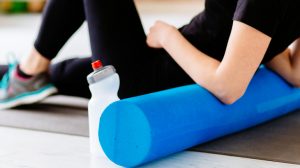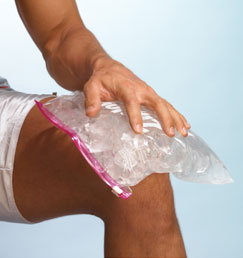Muscle Strains
A strain, sometimes referred to as a pulled muscle, is a muscle injury produced by excessive tensile stress that causes fibers to tear within the tissue. A muscle strain does not usually result from excess stretch alone, but from a combination of tension and contraction.
Muscle strains can develop when excess tension is placed on a muscle while it’s also in contraction. Due to muscle mechanics, strains are more likely while the muscle is in eccentric contraction than concentric or isometric.1,2
There are three grades of muscle strain: first degree or mild, second degree or moderate, and third degree or severe. In a first-degree strain, few muscle fibers are torn. While there might be some post-injury soreness, the individual usually returns to normal levels of activity quickly. With second-degree strains, more fibers are involved in the injury. There is a greater level of pain with this injury and a clear region of maximum tenderness in the muscle tissue.
A complete rupture of the muscle-tendon unit occurs with a grade-three strain. Some strains are classified as third degree even though the muscle still has some fibers intact because the damage is extensive. There is likely significant pain at the time of the injury. Pain can be minimal afterwards, because the ends of the muscle are separated and limb movement does not cause additional tensile stress.
Third-degree strains generally require surgical repair. In some instances, surgery is not performed because the muscle does not play a crucial role and the potential dangers of surgery outweigh the benefits. Ruptures to the rectus femoris are an example because the other three quadriceps muscles make up for the strength deficit caused by the strain.
The muscles most susceptible to strain injuries are multi-articulate muscles, which are those that cross more than one joint. The more joints crossed by a muscle, the greater is their vulnerability for strain injury. All involved joints cannot achieve full range of motion at the same time due to limited extensibility of the muscle tendon unit. If the muscle is stretched across multiple joints at the same time, it’s more susceptible to tearing from excess tensile stress.
Strains can develop in any part of the muscle, but usually occur at the musculotendinous junction.3 The junction of muscle and tendon places one tissue with higher pliability (muscle) directly adjacent to another with limited pliability and more tensile strength (tendon). As a consequence, the point of interface between the two tissues becomes a site of mechanical weakness where the strain occurs.
Muscle strains generally arise from acute injuries. However, there might be repetitive tensile forces on the muscle that cause small degrees of fiber tearing, producing a chronic strain. In most cases, the client can recall a specific movement or accident that produced the strain. Swelling might occur in the area immediately after the injury, but is likely to subside after the initial inflammatory phase (an estimated 72 hours).
Strains, both acute and chronic, are increasingly common where they have previously occurred. Scar tissue that repaired the original strain is a weak point in the muscle’s continuity, and therefore a location vulnerable to re-injury. It’s important to find out whether the client has suffered a previous injury to the area.
Following a strain, resting from offending activities for several weeks provides the body time to heal damaged tissue. Another primary goal of treatment is tension reduction in the affected muscle. Tension is reduced with massage techniques such as effleurage, stripping, broad cross-fiber sweeping, etc. In addition, it’s important to help develop a functional scar at the site of tearing and prevent scar tissue from adversely binding adjacent fibers. Deep transverse friction massage is used to develop a healthy, functional scar. Muscle strains are a common soft-tissue injury and massage is an excellent treatment option to help in the management of these conditions.
References
- Faulkner JA, Brooks SV, Opiteck JA. Injury to skeletal muscle fibers during contractions: conditions of occurrence and prevention. Phys Ther. 1993;73(12):911-921.
- Hoskins W, Pollard H. The management of hamstring injury-Part 1: Issues in diagnosis. Man Ther. May 2005;10(2):96-107.
- Garrett WE, Jr., Safran MR, Seaber AV, Glisson RR, Ribbeck BM. Biomechanical comparison of stimulated and nonstimulated skeletal muscle pulled to failure. Am J Sports Med. 1987;15(5):448-454.
Ready to #feelbetter?
You're just a click away from a wicked good massage!
-

60 Minute Massage Gift Card
$170.00 Add to cart -

90 Minute Massage Gift Card
$255.00 Add to cart -

Mini Aer Small Room Air Purifier
$149.00 Add to cart -
Sale!

Thera-Pearl Sports Pack/Hot Cold
Original price was: $14.99.$12.99Current price is: $12.99. Add to cart -

3 Somadome Sessions Gift Card
$135.00 Add to cart -

20 Minute Somadome Gift Card
$45.00 Add to cart -
Sale!

TheraBand® Stretch Strap
Original price was: $19.99.$14.99Current price is: $14.99. Add to cart -

TheraBand CLX Connective Loop
$14.99 Select options
May Flowers-Life Hack
April Showers Bring 5 Flower Hacks What do you get when you combine soda, vodka, apple cider vinegar, hair spray & bleach? Some incredible ways to preserve your flowers this season. Sure, April showers bring May flowers, but mother nature went a tad over board with it this April. So how well are you prepared…
Read More#FeelBetterBoston Recap
#FeelBetterBoston Recap The inaugural #FeelBetterBoston Massage & Community Wellness event over Marathon weekend left people with a smile on their face and genuine appreciation for all that was provided. We knew this being the first time we held such an event that we would be competing with the likes of the infamous BAA Expo and other…
Read MoreHow Do You Roll??
How Do You Roll?? Are Foam Rolling Advocates Stretching the Truth? Foam rolling is one of the most common means of self-care for so many people. It has been thought to provide many benefits such as enhanced performance, improved flexibility and speed, pain reduction and muscle recovery. Often it is referred to as a self-massage technique,…
Read MoreOn the Mend
On the Mend As we quickly approach the holy grail of running events, the Boston Marathon, we start to see a rise in our battered and beaten road warriors. Overuse conditions from months of increased training, acute injuries from falls on slippery roads and chronic aches and pains, all result in the patient surrendering to…
Read MoreLife Hack: Watch the SB LIII on TV, but LISTEN on the Radio
Life Hack: Watch the SB LIII on TV, but LISTEN on the Radio So, our beloved Pats are back in the big game again. I’m not going to relay stats and numbers that drive home the dynasty known as the New England Patriots. We are all aware of them. However, if you want to enjoy…
Read MoreCortisone Injections: Yay or Ney?
Cortisone Injections: Yay or Ney? As massage therapists, we often see patients who have been struggling to find an answer for a particular pain problem. Some of these cases are acute (sudden onset) where others may be chronic (reoccurring over a long period of time). It is not uncommon to have a patient ask us…
Read MoreChiropractic Care at The Boston Bodyworker
Chiropractic Care at The Boston Bodyworker We are excited to announce the arrival of Dr. Jean Kelly of Momentum Healthcare to our office. Dr. Kelly has been practicing in our building for the past 10 years and has been a friend to The Boston Bodyworker for almost 20 years. We are honored to have her…
Read MoreSpine Health: Don’t Ignore It!
Spine Health: Don’t Ignore It! The new year always provides us with the feeling of having a clean slate. Let’s face it, most of us don’t take very good care of our spines. 2019 can be the year that your resolutions come true. This lack of care can lead to physical discomfort and make us…
Read MoreLife Hack: Drink Tea
Life Hack: Drink Tea With the rainiest and most dreary Fall in recent time behind us and winter now in full swing, the need for us to provide optimal care for ourselves is high. Despite American’s love affair with coffee, tea is really the more versatile of the beverages. Most of us reach for a…
Read MoreLife Hack: Forward Head Posture
Life Hack: Forward Head Posture How many times in the course of a day do you roll your shoulders and neck around to alleviate “the spot” in between your shoulder blades. There are several reasons for the discomfort you are experiencing, but one way to resolve this is to do what is known as a…
Read More



